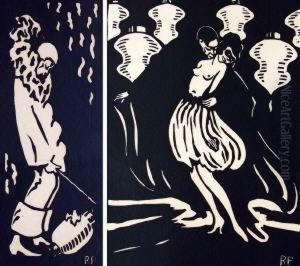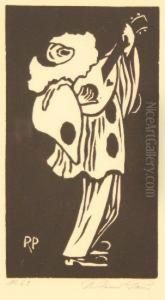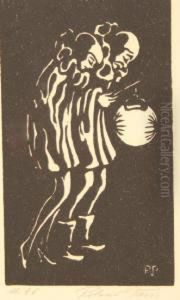Roland Paris Paintings
Roland Paris, born in 1894 in Vienna, Austria, was an exceptional artist renowned for his unique blend of caricature and the grotesque, which together created a distinctive style that was both captivating and unsettling. His artistry was not confined to a single medium; instead, he adeptly worked across various forms including sculpture, printmaking, and drawing. His early life in Vienna, a cultural hub at the turn of the century, provided him with a rich artistic education and exposure to a variety of artistic movements, which he would later blend into his own unique style.
Paris's work is often characterized by a dark humor and a satirical edge, exploring themes of human folly, societal norms, and the absurdity of life. Despite the whimsical and often playful appearance of his creations, there is a depth of meaning and a critique of contemporary society that underpins his work. This duality made his pieces particularly compelling, as they invited viewers to look beyond the surface and consider the underlying messages.
In the 1920s and 1930s, Roland Paris's work gained recognition and popularity in Europe, especially in Germany and Austria. His sculptures, often made from bronze, wood, or ivory, featured exaggerated figures, often in dynamic or exaggerated poses, reflecting the influence of both Expressionism and Art Deco. Despite the growing political tensions and the eventual rise of fascism in Europe, Paris continued to produce his art, which increasingly reflected the tumultuous social and political climate of the time.
However, with the annexation of Austria by Nazi Germany in 1938, Paris, like many artists whose work did not conform to the Nazi ideology, faced persecution. His work was deemed 'degenerate', and he was forced to flee Austria. The latter part of his career was marked by this exile, which took a toll on his artistic output and his health. Roland Paris died in 1945, leaving behind a body of work that, despite its relative obscurity at the time of his death, has since been re-evaluated and appreciated for its innovative approach and its critical engagement with the social and political issues of his time.
Throughout his career, Paris remained committed to his unique artistic vision, which stood in stark contrast to the dominant trends of his time. His legacy lives on, not only in his artworks but also in his contribution to modern art's understanding of the role of satire and caricature in critiquing and reflecting upon the human condition.


